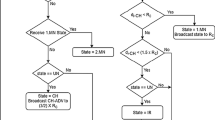Abstract
In this paper, we propose a novel energy-efficient data routing algorithm for clustered WSNs, based on Khalimsky topology. The aim of this algorithm is to compute Khalimsky paths for optimized data routing and to provide distributed clustering algorithm reducing the energy consumption and extending the network lifetime. The clustering algorithm divides WSNs into k-hop (\(k\geq 2\)) large dynamic clusters. In each cluster, nodes are arranged in concentric layers around an elected cluster-head according to well-defined criteria. Depending on its distance to the cluster-head, some nodes are selected by the triangulation theory as Khalimsky anchors to ensure optimal intra-cluster data routing. The Khalimsky anchors, located in border layers of adjacent clusters, are used for inter-cluster data routing. We prove that large clusters reduce the isolated nodes number. By this structure of multi-hops large clusters, we prove that the data routing across Khalimsky anchors alleviates the cluster heads tasks and minimizes the energy consumption. Simulation results show that our approach outperforms other protocols by achieving longer lifetime considering the energy consumption and the died nodes number.











Similar content being viewed by others
References
Akyildiz IF, Vuran MC (2010) Wireless sensor networks. Akyildiz IF series in communications and networking. Wiley, Hoboken
Amis AD, Prakash R, Vuong TH, Huynh DT (2000) Max-min D-cluster formation. In: Proceedings of the 19th annual joint conference of the IEEE computer and communications societies, conference on computer communications (IEEE INFOCOM’2000), vol 3, pp 32–41
Anastasi G, Conti M, Di Francesco M, Passarella A (2009) Energy conservation in wireless sensor networks: a survey. Ad Hoc Netw 7:537–568
Arioua M, El Assari Y, Ez-zazi I, El Oualkadi A (2016) Multi-hop cluster based routing approach for wireless sensor networks. In: Proceedings of the 7th international conference on ambient systems, networks and technologies (ANT’16), Procedia Computer Science, vol 83, pp 584–591
Atmel C (2016) ATmega328/P datasheet complete. http://ww1.microchip.com/downloads/en/DeviceDoc/Atmel-42735-8-bit-AVR-Microcontroller-ATmega328-328P_Datasheet.pdf. Accessed Apr 2018
Babu NV, Puttamadappa C, Bore Gowda SB (2013) Energy efficient two hop clustering for wireless sensor networks. Int J Comput Sci Netw Secur 13(9):23–28
Bouacida E (2008) The Jordan curve theorem in the Khalimsky plane. Appl Gen Topol 9(252):253–262
Chen Q, Ma J, Zhu Y, Zhang D, Ni LM (2007) An energy-efficient K-hop clustering framework for wireless sensor networks. In: Langendoen K, Voigt T (eds) European wireless sensor networks (EWSN), vol 4373. Lecture notes in computer science. Springer, Berlin, pp 17–33. https://doi.org/10.1007/978-3-540-69830-2_2
Gupta SK, Jain N, Sinha P (2013) Clustering protocols in wireless sensor networks: a survey. Int J Appl Inf Syst Found Comput Sci 5(2):41–50
Khalimsky ED (1999) On topologies of generalized segments. Soviet Math Dokl 10:1508–1511
Manjeshwar E, Agrawal DP (2001) TEEN: a routing protocol for enhanced efficiency in wireless sensor networks. In: Proceedings of the 15th international parallel and distributed processing symposium, San Francisco, CA, USA, pp 2009–2015
Manjeshwar E, Agrawal DP (2002) APTEEN: a hybrid protocol for efficient routing and comprehensive information retrieval in wireless sensor networks. In: Proceedings of the 2nd international workshop on parallel and distributed computing, issues in wireless networks and mobile computing, Lauderdale, FL, USA, pp 195–202
MATLOG C (2017) Modules XBee series 1 2.4 GHz (802.15.4). https://www.matlog.fr. Accessed Apr 2018
Meulenaer G, Gosset F, Standaert FX, Pereira O (2008) On the energy cost of communication and cryptography in wireless sensor networks. In: Proceedings of the IEEE international conference on wireless and mobile computing, networking and communications WIMOB’08, pp 580–585
Mezghani M, Abdellaoui M (2011) Multitasks-generic platform via WSN. Int J Distrib Parallel Syst 2(4):54–67
Mezghani M, Abdellaoui M (2015) WSN intelligent communication based on Khalimsky theory using multi-agent systems. In: Proceedings of IEEE SAI intelligent systems conference, London, UK, pp 871–876. https://ieeexplore.ieee.org/document/7361245/
Mezghani M, Abdellaoui M (2016) WSN efficient data management and intelligent communication for load balancing based on Khalimsky topology and mobile agents. In: Bi Y, Kapoor S, Bhatia R (eds) Intelligent systems and applications, studies in computational intelligence. Springer, Berlin, pp 385–404. http://www.springer.com/gp/book/9783319333847 (chapter 19)
Mezghani M, Gargouri R, Abdellaoui M (2014) Optimization of WSNs flooding rates by Khalimsky topology. Trans Netw Commun 2(6):27–41
OpenSim Ltd (2017) OMNeT++ simulation manual. https://www.omnetpp.org. Accessed Apr 2018
Qin M, Zimmermann R (2007) VCA: an energy-efficient voting-based clustering algorithm for sensor networks. J Univers Comput Sci 12(1):87–109
Quin L, Kunz T (2003) On-demand routing in MANETs: the impact of a realistic physical layer model. In: Proceedings of the international conference on ad hoc, mobile, and wireless networks, Montreal, Canada, pp 37–48
Sirsikar S, Wankhede K (2015) Comparison of clustering algorithms to design new clustering approach. In: ICAC3’15, Procedia Computer Science, vol 49, pp 147–154
Sobelec C (2017) Catalog of sensors. http://www.sobelec-tn.com/liste.php?cat=404. Accessed Apr 2018
Taruna S, Kumawat R, Purohit GN (2012) Multi-hop clustering protocol using gateway nodes in wireless sensor network. Int J Wirel Mob Netw 4(4):169–180
Woo A, Tong T, Culler D (2003) Taming the underlying challenges of reliable multihop routing in sensor networks. In: Proceedings of the 1st international conference on embedded networked sensor systems (SenSys’03), pp 14–27
Younis O, Fahmy S (2004) HEED: a hybrid, energy-efficient, distributed clustering approach for ad-hoc sensor networks. IEEE Trans Mob Comput 3(4):366–379
Zeb A, MuzahidulIslam AKM, Zareei M, Almamoon I, Mansoor N, Baharun S, Katayama Y, Komaki S (2016) Clustering analysis in wireless sensor networks: the ambit of performance metrics and schemes taxonomy. Int J Distrib Sens Netw 12(7):4979142. https://doi.org/10.1177/155014774979142
Zimmerling M, Waltenegus D, Reason JM (2007) Energy-efficient routing in linear wireless sensor networks. In: IEEE international conference on mobile adhoc and sensor systems, Pisa, Italy. https://ieeexplore.ieee.org/document/4428618/
Author information
Authors and Affiliations
Corresponding author
Additional information
Publisher's Note
Springer Nature remains neutral with regard to jurisdictional claims in published maps and institutional affiliations.
Rights and permissions
About this article
Cite this article
Mezghani, M. An efficient multi-hops clustering and data routing for WSNs based on Khalimsky shortest paths. J Ambient Intell Human Comput 10, 1275–1288 (2019). https://doi.org/10.1007/s12652-018-0950-9
Received:
Accepted:
Published:
Issue Date:
DOI: https://doi.org/10.1007/s12652-018-0950-9




